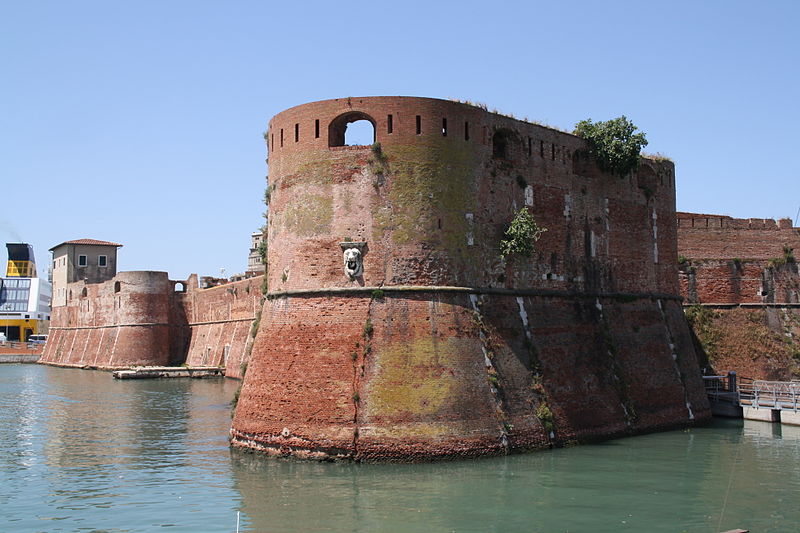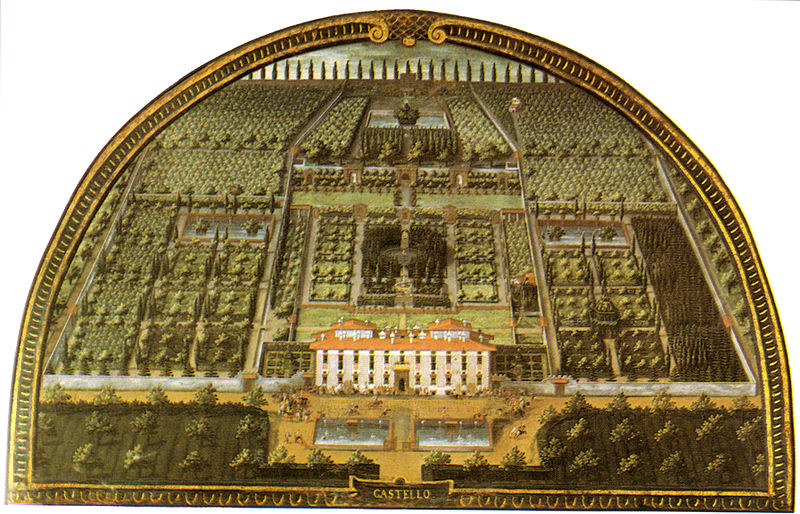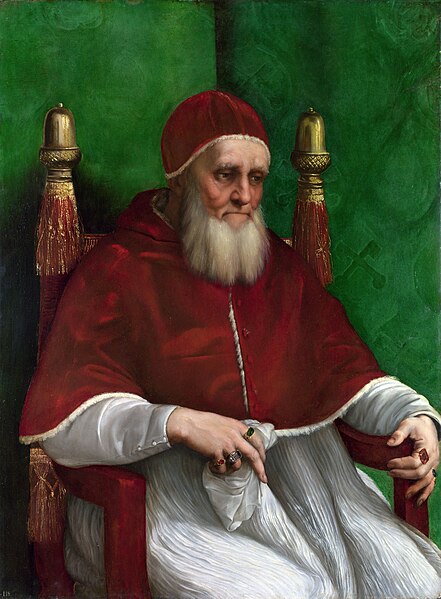 |
| Caterina Sforza |
On 26th
February Caterina arrived in Rome in Cesare’s entourage during carnival. Cesare
was met at the gates of the city by all the cardinal’s households and the papal guard. According to some accounts Caterina was allegedly dressed as the Queen of Palmyra, in black with a restraining gold chain round her neck. Cesare
was also soberly garbed;
‘Don Cesare had around him a
hundred grooms, each one dressed in a cloak of black velvet with black leather
boots and carrying a new halberd in his hand. Don Cesare himself was dressed in
a coat of black velvet reaching to his knees, with a collar of simple and
severe design.’[i]
Alexander VI
greeted Caterina cordially upon her forced return to the eternal city. She was
lodged in the Villa Belvedere[ii]
within the Vatican grounds; the pope carefully avoided treating her like an
exhibit in Cesare’s triumph, for fear of an adverse reaction on the part of his
ally Louis XII. On the 27th February the Mantuan ambassador met with
Caterina and described her as ‘still
furious and strong-willed’.
Caterina was
allowed her servants and ladies-in-waiting along with her confessor. Upon
Caterina refusing to relinquish formal control of Forli and Imola back to the
church twenty soldiers were sent to guard her day and night. In late May, with
the help of a Milanese friar, one Lauro Bossi, Caterina attempted to escape.
She was betrayed by one of Bossi’s go-betweens and was captured by the guard.
For her
pains Caterina found herself imprisoned in a small dungeon in the Castel Sant’
Angelo. She was allowed two servants to attend to her. Caterina’s plight
was not aided by the fall of Ludovico Sforza who was taken off to imprisonment
in France. Hitherto, Caterina had been looked after for fear that Ludovico
would march on Rome in defence
of his niece.
Freedom
Ottaviano
was reluctant to aid his mother, with whom he had a conflicted relationship.
While Caterina got on with her younger children, she had a troubled
relationship with both of Girolamo’s sons; Ottaviano, who had inherited much of
his father’s character and had not cared for Caterina’s refusal to turn over
control of his lands to him, and Cesare[iii].
Ottaviano offered to hand over the lordship of both Imola
and Forli in return for his mother’s release and a cardinal’s hat for his
brother Cesare. Ottaviano and Cesare wrote to Caterina saying that they were
now washing their hands of her.
 |
| Fortezza Vecchia, Livorno |
‘If His Holiness does not grant our latest petition then don’t expect any
more from us. We have impoverished ourselves.’[iv]
Alexander refused the offer.
In June 1501 Alexander received a demand from Yves d’Allègre[v], on
behalf of Louis XII, that Caterina be freed. He agreed in return for her formal
renunciation of Imola and Forli. By this time a shadow of her former self, Caterina
signed the required documents on 30th June and left the Castel
Sant’Angelo. She stayed as a guest of Cardinal Raffaele Riario for a few days.
2,000 ducats[vi]
were forthcoming from Florence to cover the cost of her return there. Caterina
travelled by night in an attempt to avoid any mischance on the part of Cesare
or his family. She left from Ostia and
travelled by sea to Livorno.
Legal Troubles
Throughout her confinement Caterina’s main worry was
Ludovico who had fallen into the hands of his paternal uncle, who had made
himself Ludovico’s guardian. Lorenzo di Popolani de’ Medici had his eye on his
nephew’s inheritance and he applied to have Caterina declared unfit. With
judicial use of his fortune Lorenzo was able to persuade the Florentine courts to award him custody
of the four year old Ludovico.
As soon as she arrived in Florence Caterina received news
from a relative who reported that;
‘He [Ludovico] has grown and is a beautiful gallant boy.’[vii]
 |
| Villa di Castello |
Lorenzo il Popolano left Florence with Ludovico almost
immediately and Caterina wrote to Mantua and to her sister Bianca Maria the Holy
Roman Empress. Caterina was looking for support in high places to get her son
back. She was not allowed to see Ludovico during the battle for custody.
Caterina
moved to the Medici Villa di Castello[viii] to get away from her
brother-in-law’s harrying. Penniless herself, Caterina was being pressed by
Ottaviano and Cesare for financial assistance.
 |
| Julius II |
In June 1502
Lorenzo tried to force her to leave the sanctuary she had found, claiming the
Villa di Castello as his own personal property and used the caretaker to make
her life miserable. She had no sheets or tablecloths and had to beg her
children for six forks. When her stepson Scipione Riario arrived to visit
Caterina was worried about the additional cost of providing for him and his
companions.
On the 20th
May Lorenzo died and Caterina was able to take custody of Ludovico once again.
The dispute over the control of Caterina’s dower monies was not settled until 5th
June 1505. Caterina returned to the Villa di Castello with Ludovico, whose name
she now changed to Giovanni, and Carlo, her son by Giacomo Feo. She taught
Giovanni how to ride and hunt.
On 28th
July 1503 Caterina married her daughter Bianca off to Troilo Rossi, the first Marchese di San Secondo.
Less than a month later Pope Alexander died and Cesare fell ill[ix].
After a short reign by Pius III,
Guiliano della Rovere ascended the papal throne as Julius II.
Alchemical Experiments
 |
| Isabella d'Este |
Like many other
fashionable ladies, including Lucrezia Borgia and Isabella d’Este, Caterina made her own perfumes and love potions and diverse
ointments to encourage ‘masculine
virility’ as well as salves and cosmetics, sleeping potions and
painkillers. The ingredients Caterina used were often esoteric and included
such items as newts and the juice of red ants. Her expenditure on ingredients
outran her income[x].
Her experiments were posthumously published as Gli Esperimenti.
Caterina
still held hopes that Julius II would grant Forli to Ottaviano and in October
1503 advised him to press the pope on the matter, writing;
‘The iron is hot and it is
time to strike it….Guard yourself from those you trust and those who offer you
advice. Know the foul tempers that are all around you; if you allow yourself to
be led by others, you will wind up with your cap over your eyes, so wake up!’[xi]
 |
| Viterbo Cathedral |
Alas for
Ottaviano Caterina’s hopes came to nothing; Ottaviano and Cesare did not make
many friends, having inherited their father’s arrogance. In 1507 Ottaviano
became bishop of Viterbo and Volterra, the dioceses having been ceded to
him by his uncle Raffaello Riario. He still hung on his mother’s purse strings
and wrote demands for money for clothing, so that his fellow prelates did not
outshine him.
For herself
Caterina spent her days in correspondence and took lovers to her bed, although
neither they nor she were as young as they were in her heyday. In 1508 Bianca
brought her son Pietro Maria and her new daughter to visit their grandmother.
Pietro Maria was left in Caterina’s care so that she could teach him to ride
and hunt, as she had done for Giovanni who had little interest in schooling.
Caterina
died on 28th May 1509; she suffered pleurisy which made breathing
difficult, brought on by the quartan fever she had suffered from for most of
her adult life. She made her will that day, leaving a bequest for the upkeep of
the cathedral in Florence and paying for 1,000 masses for her soul. She left
provision for her grandchildren and left Carlo Feo 2,000 gold ducats[xii].
Caterina’s
favourite child Giovanni was to follow in his maternal grandfather’s footsteps
to become a condottiere; known as Giovanni della Bande Nere. He married Maria Salviati, the
daughter of Jacopo Salviati and Lucrezia di Lorenzo de' Medici. His
son was Cosimo I de'
Medici, Grand Duke of Tuscany.
Bibliography
At the Court
of the Borgia – Johann Burchard, the Folio Society 1990
Lucrezia Borgia – Rachel Erlanger, Michael Joseph 1979
The Deadly
Sisterhood – Leonie Frieda, Harper Collins 2013
The Borgias
– Mary Hollingsworth, Quercus Editions Ltd 2014
Tigress of
Forli – Elizabeth Lev, Head of Zeus Ltd, 2012
The Borgias
– GJ Meyer, Bantam Books 2013
Absolute
Monarchs – John Julius Norwich, Random House 2011
Niccolo’s
Smile – Maurizio Viroli, IB Tauris & Co Ltd 2001
www.wikipedia.en
[i]
At the Court of the Borgia - Burchard
[iv]
Tigress of Forli - Lev
[v]
Commander of the French troops in Italy
[vi] In 2016 the
relative: historic standard of living value of that income or wealth is £1,322,000.00, labour earnings of that income or wealth is £13,040,000.00, economic status value of that income or wealth is £34,600,000.00, economic power value of that income or wealth is £808,200,000.00 www.measuringworth.com
[vii]
The Deadly Sisterhood - Frieda
[viii]
In the hills above Florence
[ix]
Rumour had it that the two men ate from a poisoned dish intended for another
victim
[x]
She was in debt to the tune of 587 florins at the time of her death. In 2016 the relative: historic standard of
living
value of that income or wealth is £483,000.00, labour earnings of that income or wealth is
£3,817,000.00, economic status value of that income or wealth is £9,866,000.00, economic power value of that income or
wealth is £227,700,000.00 www.measuringworth.com
[xi]
Tigress of Forli - Lev
[xii]
In 2016 the relative: historic standard of
living
value of that income or wealth is £1,646,000.00, labour earnings of that income or wealth is
£13,010,000.00, economic status value of that income or wealth is £33,610,000.00, economic power value of that income or
wealth is £775,900,000.00 www.measuringworth.com
2,000 ducats, a sum mentioned twice, would have been about the equivalent of 400 English sovereigns, about the yearly income of a baron or a wealthy wool merchant, enough to pay the salary of 20 schoolmasters or one hundred labourers for a year. A ducat was approximately 4/- to 4/8d and I've erred there on its lowest purchasing power. It was considered approximately equivalent to the Florentine Florin, the French Écu and the English Crown. The Crown was generally reckoned to be 5/-
ReplyDelete